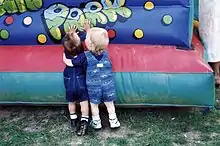Friendship
Friendship is a relationship of mutual affection between people.[1] It is a stronger form of interpersonal bond than an association, and has been studied in academic fields such as communication, sociology, social psychology, anthropology, and philosophy. Various academic theories of friendship have been proposed, including social exchange theory, equity theory, relational dialectics, and attachment styles.

| Part of a series on |
| Love |
|---|
Red-outline heart icon |
Although there are many forms of friendship, some of which may vary from place to place, certain characteristics are present in many types of such bonds. Such characteristics include affection, kindness, love, virtue, sympathy, empathy, honesty, altruism, loyalty, generosity, forgiveness, mutual understanding and compassion, enjoyment of each other's company, trust, and the ability to be oneself, express one's feelings to others, and make mistakes without fear of judgment from the friend. Friendship is an essential aspect of relationship building skills.
Developmental psychology
Childhood

The understanding of friendship in children tends to be more heavily focused on areas such as common activities, physical proximity, and shared expectations.[2]:498[lower-alpha 1] These friendships provide opportunity for playing and practicing self-regulation.[3]:246 Most children tend to describe friendship in terms of things like sharing, and children are more likely to share with someone they consider to be a friend.[3]:246[4][5] As children mature, they become less individualized and are more aware of others. They gain the ability to empathize with their friends, and enjoy playing in groups. They also experience peer rejection as they move through the middle childhood years. Establishing good friendships at a young age helps a child to be better acclimated in society later on in their life.[4]
Based upon the reports of teachers and mothers, 75% of preschool children had at least one friend. This figure rose to 78% through the fifth grade, as measured by co-nomination as friends, and 55% had a mutual best friend.[3]:247 About 15% of children were found to be chronically friendless, reporting periods without mutual friends at least six months.[3]:250
Potential benefits of friendship include the opportunity to learn about empathy and problem solving.[6] Coaching from parents can be useful in helping children to make friends. Eileen Kennedy-Moore describes three key ingredients of children's friendship formation: (1) openness, (2) similarity, and (3) shared fun.[7][8][9] Parents can also help children understand social guidelines they haven't learned on their own.[10] Drawing from research by Robert Selman[11] and others, Kennedy-Moore outlines developmental stages in children's friendship, reflecting an increasing capacity to understand others' perspectives: "I Want It My Way", "What's In It For Me?", "By the Rules", "Caring and Sharing", and "Friends Through Thick and Thin."[12]
Adolescence

In adolescence, friendships become "more giving, sharing, frank, supportive, and spontaneous." Adolescents tend to seek out peers who can provide such qualities in a reciprocal relationship, and to avoid peers whose problematic behavior suggest they may not be able to satisfy these needs.[13] Personal characteristics and dispositions are also features sought by adolescents, when choosing whom to begin a friendship with.[14] Relationships begin to maintain a focus on shared values, loyalty, and common interests, rather than physical concerns like proximity and access to play things that more characterize childhood.[3]:246
A study performed at the University of Texas at Austin examined over 9,000 American adolescents to determine how their engagement in problematic behavior (such as stealing, fighting, and truancy) was related to their friendships. Findings indicated that adolescents were less likely to engage in problem behavior when their friends did well in school, participated in school activities, avoided drinking, and had good mental health. The opposite was found regarding adolescents who did engage in problematic behavior. Whether adolescents were influenced by their friends to engage in problem behavior depended on how much they were exposed to those friends, and whether they and their friendship groups "fit in" at school.[15]
A study by researchers from Purdue University found that friendships formed during post-secondary education last longer than friendships formed earlier.[16] In late adolescence cross-racial friendships tend to be uncommon, likely due to prejudice and cultural differences.[14]
Adulthood



Friendship in adulthood provides companionship, affection, as well as emotional support, and contributes positively to mental well-being and improved physical health.[17]:426
Adults may find it particularly difficult to maintain meaningful friendships in the workplace. "The workplace can crackle with competition, so people learn to hide vulnerabilities and quirks from colleagues. Work friendships often take on a transactional feel; it is difficult to say where networking ends and real friendship begins."[18] Most adults value the financial security of their jobs more than friendship with coworkers.[19]
The majority of adults have an average of two close friends.[20] Numerous studies with adults suggest that friendships and other supportive relationships do enhance self-esteem.[21]
Older adults
Older adults continue to report high levels of personal satisfaction in their friendships as they age, even as the overall number of friends tends to decline. This satisfaction is associated with an increased ability to accomplish activities of daily living, as well as a reduced decline in cognitive abilities, decreased instances of hospitalization, and better outcomes related to rehabilitation.[17]:427 The overall number of reported friends in later life may be mediated by increased lucidity, better speech and vision, and marital status.[22]:53
As one review phrased it:
Research within the past four decades has now consistently found that older adults reporting the highest levels of happiness and general well being also report strong, close ties to numerous friends.[23]
As family responsibilities and vocational pressures lessen, friendships become more important. Among the elderly, friendships can provide links to the larger community, serve as a protective factor against depression and loneliness, and compensate for potential losses in social support previously given by family members.[24]:32–33 Especially for people who cannot go out as often, interactions with friends allow for continued societal interaction. Additionally, older adults in declining health who remain in contact with friends show improved psychological well-being.[25]
Developmental issues
Attention deficit hyperactivity disorder
Children with attention deficit hyperactivity disorder (ADHD) may have difficulty forming and maintaining friendships, due to a limited ability to build social skills through observational learning, difficulties attending to social cues, and because of the social impacts of impulsive behavior and a greater tendency to engage in behavior that may be seen as disruptive by their peers.[26][27] In a 2007 review, no treatment was identified which effectively address peer functioning in children with ADHD, and treatments which addressed other aspects of the disorder were not found to eliminate issues related to peer functioning.[26]
Autism
Certain symptoms of autism spectrum disorders can interfere with the formation of interpersonal relations, such as a preference for routine actions, resistance to change, obsession with particular interests or rituals, and a lack of social skills. Children with autism have been found to be more likely to be close friends of one person, rather than having groups of friends. Additionally, they are more likely to be close friends of other children with some sort of a disability.[28] A sense of parental attachment aids in the quality of friendships in children with autism spectrum disorders; a sense of attachment with one's parents compensates for a lack of social skills that would usually inhibit friendships.[29]
A study done by Frankel et al. showed that parental intervention and instruction plays an important role in such children developing friendships.[30] Along with parental intervention, school professionals play an important role in teaching social skills and peer interaction. Paraprofessionals, specifically one-on-one aides and classroom aides, are often placed with children with autism spectrum disorders in order to facilitate friendships and guide the child in making and maintaining substantial friendships.[31]
Although lessons and training may help peers of children with autism, bullying is still a major concern in social situations. According to Anahad O'Connor of The New York Times, bullying is most likely to occur against children with autism spectrum disorders who have the most potential to live independently. Such children are more at risk because they have as many of the rituals and lack of social skills as children with lower-functioning (more obvious) autism, but they are more likely to be mainstreamed in school, since they are on the higher-functioning (less obvious) end of the autism spectrum. Children with autism have more difficulty attending to social cues, and so may not always recognize when they are being bullied.[32]
Down syndrome
Children with Down syndrome have increased difficulty forming friendships. They experience a language delay causing them to have a harder time playing with other children. Most children with Down syndrome may prefer to watch other students and play alongside a friend but not with them, mostly because they understand more than they can outwardly express. In preschool years, children with Down syndrome can benefit from the classroom setting, surrounded by other children and less dependent on adult aid. Children with this disability benefit from a variety of interactions with both adults and children. At school, ensuring an inclusive environment in the classroom can be difficult, but proximity to close friends can be crucial for social development.[33][34]
Health
Studies have found that strong social supports improve a person's prospects for good health and longevity. Conversely, loneliness and a lack of social supports have been linked to an increased risk of heart disease, viral infections, and cancer, as well as higher mortality rates overall. Two researchers have even termed friendship networks a "behavioral vaccine" that boosts both physical and mental health.[35]
There is a large body of research linking friendship and health, but the precise reasons for the connection remain unclear. Most of the studies in this area are large prospective studies that follow people over time, and while there may be a correlation between the two variables (friendship and health status), researchers still do not know if there is a cause and effect relationship, such as the notion that good friendships actually improve health. A number of theories have attempted to explain this link. These theories have included that good friends encourage their friends to lead more healthy lifestyles; that good friends encourage their friends to seek help and access services when needed; that good friends enhance their friends' coping skills in dealing with illness and other health problems; and that good friends actually affect physiological pathways that are protective of health.[36]
Mental health
The lack of friendship has been found to play a role in increasing risk of suicidal ideation among female adolescents, including having more friends who were not themselves friends with one another. However, no similar effect was observed for males.[37][38] Having few or no friends is a major indicator in the diagnosis of a range of mental disorders.[13]
Higher friendship quality directly contributes to self-esteem, self-confidence, and social development.[21] A World Happiness Database study found that people with close friendships are happier, although the absolute number of friends did not increase happiness.[39] Other studies have suggested that children who have friendships of a high quality may be protected against the development of certain disorders, such as anxiety and depression.[40][41] Conversely, having few friends is associated with dropping out of school, as well as aggression, and adult crime.[2]:500 Peer rejection is also associated with lower later aspiration in the workforce, and participation in social activities, while higher levels of friendship was associated with higher adult self-esteem.[2]:500–01
Dissolution
The dissolution of a friendship may be viewed as a personal rejection, or may be the result of natural changes over time, as friends grow more distant both physically and emotionally. The disruption of friendships has been associated with increased guilt, anger and depression, and may be highly stressful events, especially in childhood. However, potential negative effects can be mitigated if the dissolution of a friendship is replaced with another close relationship.[3]:248
Demographics
Friends tend to be more similar to one another in terms of age, gender, behavior, substance abuse, personal disposition, and academic performance.[3]:248[17]:426[23]:55–56 In ethnically diverse countries, there is broad evidence that children and adolescents tend to form friendships with others of the same race or ethnicity, beginning in preschool, and peaking in middle or late childhood.[3]:264
Gender differences
In general, female-female friendship interactions among children tend to be more focused on interpersonal connections and mutual support, while male-male interaction tends to be more focused on social status, and may actively discourage the expression of emotional needs.[42]:320–02 Females report more anxiety, jealousy, and relational victimization and less stability related to their friendships, and males report higher levels of physical victimization. Nevertheless, males and females tend to report comparative levels of satisfaction with their friendships.[3]:249–50 Regarding same-sex friendships women tend to be more expressive and intimate in their same-sex friendships and have a smaller range of friends.[14] Males are more likely to define intimacy in terms of shared physical experiences while females are more likely to define it in terms of shared emotional ones. Males are less likely to make emotional or personal disclosures to other males, because this could potentially be information used against them. They will disclose this to females however (as they are not in competition with them) and males tend to regard friendships with females as more meaningful, intimate and pleasant. Male-male friendships are generally more like alliances while female-female friendships are generally much more attachment based. This also means that the end of male-male friendships tends to be less emotionally upsetting than that of female-female friendships.[43][44]
Among older adults, women tend to be more socially adept than their male peers, and many older men may rely upon a female companion, such as a spouse, in order to compensate for their comparative lack of social skills.[23]:55 Research has also found that women are more likely than men to self-report having a best friend.[45]
Culture
In Western cultures, friendships are often seen as lesser to familial or romantic.[46] When discussing taboos of friendship it was found that Chinese respondents found more than their British counterparts.[14]
Interspecies

Friendship is found among animals of higher intelligence, such as higher mammals and some birds. Cross-species friendships are common between humans and domestic animals. Cross-species friendships may also occur between two non-human animals, such as dogs and cats.
See also
- Blood brother
- Boston marriage
- Bromance
- Casual relationship
- Cross-sex friendships
- Female bonding
- Fraternization
- Frenemy
- Friend of a friend
- Friendship Day
- Imaginary friend
- Intimate relationship
- Kalyāṇa-mittatā (spiritual friendship)
- Male bonding
- Nicomachean Ethics, Books VIII and IX: Friendship and partnership
- Platonic love
- Romantic friendship
- Social connection
- Theorem on friends and strangers
- Womance
Notes
- In comparison to older respondents, who tend to describe friendship in terms of psychological rather than mostly physical aspects.[2]:498
References
- "Definition for friend". Oxford Dictionaries. Oxford Dictionary Press. Retrieved 25 May 2012.
- Bremner, J. Gavin (2017). An Introduction to Developmental Psychology. John Wiley & Sons. ISBN 978-1-4051-8652-0. Retrieved 26 September 2017.
- Zelazo, Philip David (2013). The Oxford Handbook of Developmental Psychology, Vol. 2: Self and Other. OUP US. ISBN 978-0-19-995847-4. Retrieved 26 September 2017.
- Newman, B.M. & Newman, P.R. (2012). Development Through Life: A Psychosocial Approach. Stanford, CT.
- "Your Childhood Friendships Are The Best Friendships You'll Ever Have". 17 Jun 2015. Retrieved 21 June 2016.
- Kennedy-Moore, E. (2013). "What Friends Teach Children".
- Kennedy-Moore, E. (2012). "How children make friends (part 1)".
- Kennedy-Moore, E. (2012). "How children make friends (part 2)".
- Kennedy-Moore, E. (2012). "How children make friends (part 3)".
- Elman, N.M. & Kennedy-Moore, E. (2003). The Unwritten Rules of Friendship: Simple Strategies to Help Your Child Make Friends. New York: Little, Brown.
- Selman, R.L. (1980). The Growth of Interpersonal Understanding: Developmental and Clinical Analyses. Academic Press: New York.
- Kennedy-Moore, E. (2012). "Children's Growing Friendships".
- Reisman, John M. (September 1, 1985). "Friendship and its Implications for Mental Health or Social Competence". The Journal of Early Adolescence. 5 (3): 383–91. doi:10.1177/0272431685053010.
- Verkuyten, Maykel (1996-10-01). "Culture and Gender Differences in the Perception of Friendship by Adolescents". International Journal of Psychology. 31 (5): 207–217. doi:10.1080/002075996401089. ISSN 0020-7594.
- Crosnoe, R., & Needham, B. (2004) Holism, contextual variability, and the study of friendships in adolescent development. University of Texas at Austin.
- Sparks, Glenn (August 7, 2007). Study shows what makes college buddies lifelong friends. Purdue University.
- Schulz, Richard (2006). The Encyclopedia of Aging: Fourth Edition, 2-Volume Set. Springer Publishing Company. ISBN 978-0-8261-4844-5. Retrieved 27 September 2017.
- Williams, Alex (13 July 2012). "Friends of a Certain Age: Why Is It Hard To Make Friends Over 30?". The New York Times. Retrieved October 25, 2012.
- Bryant, Susan. "Workplace Friendships: Asset or Liability?". Monster.com. Retrieved October 25, 2012.
- Willis, Amy (November 8, 2011). "Most adults have 'only two close friends'". The Telegraph. London. Retrieved August 11, 2013.
- Berndt, T.J. (2002). Friendship Quality and Social Development. American Psychological Society. Purdue University.
- Blieszner, Rosemary; Adams, Rebecca G. (1992). Adult Friendship. Sage. ISBN 978-0-8039-3673-7. Retrieved 27 September 2017.
- Nussbaum, Jon F.; Federowicz, Molly; Nussbaum, Paul D. (2010). Brain Health and Optimal Engagement for Older Adults. Editorial Aresta S.C. ISBN 978-84-937440-0-7. Retrieved 27 September 2017.
- Burleson, Brant R. (2012). Communication Yearbook 19. Routledge. ISBN 978-0-415-87317-8. Retrieved 27 September 2017.
- Laura E. Berk (2014). Pearson – Exploring Lifespan Development, 3/E. p. 696. ISBN 978-0-205-95738-5.
- Hoza, Betsy (June 7, 2007). "Peer Functioning in Children With ADHD". Journal of Pediatric Psychology. 32 (6): 101–06. doi:10.1016/j.ambp.2006.04.011. PMC 2572031. PMID 17261489.
- Wiener, Judith; Schneider, Barry H. (2002). "A multisource exploration of the friendship patterns of children with and without learning disabilities". Journal of Abnormal Child Psychology. 30 (2): 127–41. doi:10.1023/A:1014701215315. PMID 12002394. Retrieved 26 September 2017.
- Bauminger, Nirit; Solomon, Marjorie; Aviezer, Anat; Heung, Kelly; Gazit, Lilach; Brown, John; Rogers, Sally J. (3 January 2008). "Children with Autism and Their Friends: A Multidimensional Study of Friendship in High-Functioning Autism Spectrum Disorder". Journal of Abnormal Child Psychology. 36 (2): 135–50. doi:10.1007/s10802-007-9156-x. PMID 18172754.
- Bauminger, Nirit; Solomon, Marjorie; Rogers, Sally J. (29 December 2009). "Predicting Friendship Quality in Autism Spectrum Disorders and Typical Development". Journal of Autism and Developmental Disorders. 40 (6): 751–61. doi:10.1007/s10803-009-0928-8. PMC 2864904. PMID 20039110.
- Frankel, Fred; Myatt, Robert; Sugar, Catherine; Whitham, Cynthia; Gorospe, Clarissa M.; Laugeson, Elizabeth (8 January 2010). "A Randomized Controlled Study of Parent-assisted Children's Friendship Training with Children having Autism Spectrum Disorders". Journal of Autism and Developmental Disorders. 40 (7): 827–42. doi:10.1007/s10803-009-0932-z. PMC 2890979. PMID 20058059.
- Rossetti, Zachary; Goessling, Deborah (July–August 2010). "Paraeducators' Roles in Facilitating Friendships Between Secondary Students With and Without Autism Spectrum Disorders or Developmental Disabilities". Teaching Exceptional Children. 6. 42 (6): 64–70. doi:10.1177/004005991004200608.
- O'Connor, Anahad (3 September 2012). "School Bullies Prey on Children With Autism". The New York Times.
- "Recreation & Friendship." Recreation & Friendship – National Down Syndrome Society. n.p., n.d. Web. 17 Nov. 2016.
- "Social Development for Individuals with Down Syndrome – An Overview." Information about Down Syndrome. Down Syndrome Education International, n.d. Web. 17 Nov. 2016.
- L'Abate, Luciano, ed. (2007). Low-Cost Approaches to Promote Physical and Mental Health: Theory, Research, and Practice. New York: Springer-Verlag. pp. 455–472. ISBN 978-0-387-36898-6.
- Social networks and health: It's time for an intervention trial. 2005. Jorm, Anthony F. Journal of Epidemiology & Community Health. Vol 59(7) Jul 2005, 537–38.
- "Friendships play key role in suicidal thoughts of girls, but not boys". EurekAlert!. Ohio State University. January 6, 2004. Retrieved 26 September 2017.
- Bearman, Peter S.; Moody, James (January 1, 2004). "Suicide and Friendships Among American Adolescents". American Journal of Public Health. 94 (1): 89–95. doi:10.2105/AJPH.94.1.89. PMC 1449832. PMID 14713704.
- "Can we make ourselves happier?". BBC News. 1 July 2013.
- Brendgen, M.; Vitaro, F.; Bukowski, W.M.; Dionne, G.; Tremblay, R.E.; Boivin, M. (2013). "Can friends protect genetically vulnerable children from depression?". Development and Psychopathology. 25 (2): 277–89. doi:10.1017/s0954579412001058. PMID 23627944.
- Bukowski, W.M.; Hoza, B.; Boivin, M. (1994). "Measuring friendship quality during pre- and early adolescence: the development and psychometric properties of the friendship qualities scale". Journal of Social and Personal Relationships. 11 (3): 471–84. doi:10.1177/0265407594113011.
- Harris, Margaret (2002). Developmental Psychology: A Student's Handbook. Taylor & Francis. ISBN 978-1-84169-192-3. Retrieved 26 September 2017.
- Campbell, Anne. A mind of her own: The evolutionary psychology of women. OUP Oxford, 2013, pp.108-110
- David-Barrett, Tamas, Anna Rotkirch, James Carney, Isabel Behncke Izquierdo, Jaimie A. Krems, Dylan Townley, Elinor McDaniell, Anna Byrne-Smith, and Robin IM Dunbar. "Women favour dyadic relationships, but men prefer clubs: cross-cultural evidence from social networking." PloS one 10, no. 3 (2015): e0118329.
- Heingartner, Douglas (2020-10-20). "Women are more likely than men to say they have a best friend". PsychNewsDaily. Retrieved 2020-10-21.
- Tillmann-Healy, Lisa M. (2003-10-01). "Friendship as Method". Qualitative Inquiry. 9 (5): 729–749. doi:10.1177/1077800403254894. ISSN 1077-8004.
Further reading
- Bray, Alan (2003). The Friend. Chicago: University of Chicago Press. ISBN 978-0-226-07181-7.
- Cicero, Marcus Tullius. Laelius de Amicitia.
- Emerson, Ralph Waldo (1841). "Friendship". Essays: First Series. Retrieved 18 August 2013.
- Brian Hare and Vanessa Woods, "Survival of the Friendliest: Natural selection for hypersocial traits enabled Earth's apex species to best Neandertals and other competitors", Scientific American, vol. 323, no. 2 (August 2020), pp. 58–63.
- Lepp, Ignace (1966). The Ways of Friendship. New York: The Macmillan Company.
- Said, Edward (1979). Orientalism. US: Vintage Books. ISBN 978-0-394-74067-6.
- Terrell, John Edward (2014). A Talent for Friendship: Rediscovery of a Remarkable Trait. Oxford University Press. ISBN 978-0199386451.
External links
| Wikiquote has quotations related to: Friendship |
| Look up friendship in Wiktionary, the free dictionary. |
 Media related to Friends at Wikimedia Commons
Media related to Friends at Wikimedia Commons- BBC Radio 4 series "In Our Time", on Friendship, 2 March 2006
- Friendship at the Stanford Encyclopedia of Philosophy